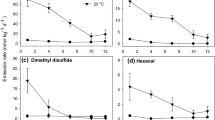Abstract
Volatile compounds in raw and cooked black rice (cv. Sintoheugmi) samples with different degrees of milling (step 0, 0%; step 1, 4.2%; and step 2, 10.5%, w/w) were investigated by headspace solid-phase microextraction and gas chromatography–mass spectrometry. A total of 101 volatile compounds were found. Among them, 44 compounds found in raw black rice were absent in cooked black rice and 20 compounds were newly formed in cooked black rice. The 8 identified major odor-active volatile compounds in raw and cooked black rice included 3 phenols (guaiacol, 4-vinylphenol, and 2-methoxy-4-vinylphenol), 2 benzenes (benzaldehyde and p-xylene), 2 furans (2-butylfuran and 2-pentylfuran), and 1 terpene (calamenene). Additionally, fatty acid oxidation products such as hexanal, 2-nonenal, octanal, and 2-pentylfuran were found in raw and cooked black rice samples. The relative concentrations of these volatile compounds were significantly higher in step 0 than in step 2 of raw and cooked black rice (p < 0.05). Partially milled cooked black rice (i.e., step 1) contained ~ 80% guaiacol (a favorable unique black rice flavor) of unpolished rice (step 0), with similar levels of several lipid oxidation indicator volatile products (e.g., 2-nonenal and 2-pentyl furan) of fully milled rice (step 2). Thus, partially milled black rice should be consumed rather than fully milled black rice.


Similar content being viewed by others
References
Hu C, Zawistowski J, Ling W, Kitts DD (2003) Black rice (Oryza sativa L. indica) pigmented fraction suppresses both reactive oxygen species and nitric oxide in chemical and biological model systems. J Agric Food Chem 51:5271–5277
Yang DS, Lee KS, Jeong OY, Kim KJ, Kays SJ (2007) Characterization of volatile aroma compounds in cooked black rice. J Agric Food Chem 56:235–240
Schranz M, Lorber K, Klos K, Kerschbaumer J, Buettner A (2017) Influence of the chemical structure on the odor qualities and odor thresholds of guaiacol-derived odorants, part 1: alkylated, alkenylated and methoxylated derivatives. Food Chem 232:808–819
Shitanda D, Nishiyama Y, Koide S (2001) Performance analysis of an impeller husker considering the physical and mechanical properties of paddy rice. J Agric Eng Res 79:195–203
Arthur CL, Pawliszyn J (1990) Solid phase microextraction with thermal desorption using fused silica optical fibers. Anal Chem 62:2145–2148
Bryant R, McClung A (2011) Volatile profiles of aromatic and non-aromatic rice cultivars using SPME/GC–MS. Food Chem 124:501–513
Grimm CC, Bergman C, Delgado JT, Bryant R (2001) Screening for 2-acetyl-1-pyrroline in the headspace of rice using SPME/GC–MS. J Agric Food Chem 49:245–249
Laguerre M, Mestres C, Davrieux F, Ringuet J, Boulanger R (2007) Rapid discrimination of scented rice by solid-phase microextraction, mass spectrometry, and multivariate analysis used as a mass sensor. J Agric Food Chem 55:1077–1083
Ceva-Antunes PMN, Bizzo HR, Silva AS, Carvalho C, Antunes O (2006) Analysis of volatile composition of siriguela (Spondias purpurea L.) by solid phase microextraction (SPME). LWT Food Sci Technol 39:437–443
Samyor D, Deka SC, Das AB (2016) Evaluation of physical, thermal, pasting characteristics and mineral profile of pigmented and nonpigmented rice cultivars. J Food Process Preserv 40:174–182
Bhat FM, Riar CS (2017) Physicochemical, cooking, and textural characteristics of grains of different rice (Oryza sativa L.) cultivars of temperate region of India and their interrelationships. J Texture Stud 48:160–170
Hiemori M, Koh E, Mitchell AE (2009) Influence of cooking on anthocyanins in black rice (Oryza sativa L. japonica var. SBR). J Agric Food Chem 57:1908–1914
Kim HY, Hwang SH, Lee JH (2017) Effect of fermented vinegar on the reduction in trimethylamine in konjac glucomannan gel. Appl Biol Chem 60:281–285
Kim MS, Baek SH, Park SU, Im KH, Kim JK (2017) Targeted metabolite profiling to evaluate unintended metabolic changes of genetic modification in resveratrol-enriched rice (Oryza sativa L.) Appl. Biol Chem 60:205–214
Lee J, Xiao L, Zhang G, Ebeler SE, Mitchell AE (2014) Influence of storage on volatile profiles in roasted almonds (Prunus dulcis). J Agric Food Chem 62:11236–11245
Baek H, Cadwallader K (1996) Volatile compounds in flavor concentrates produced from crayfish-processing byproducts with and without protease treatment. J Agric Food Chem 44:3262–3267
Lamberts L, De Bie E, Vandeputte GE, Veraverbeke WS, Derycke V, De Man W, Delcour JA (2007) Effect of milling on colour and nutritional properties of rice. Food Chem 100:1496–1503
Alizadeh R, Najafi NM, Kharrazi S (2011) A new solid phase micro extraction for simultaneous head space extraction of ultra traces of polar and non-polar compounds. Anal Chim Acta 689:117–121
Buttery RG, Turnbaugh JG, Ling LC (1988) Contribution of volatiles to rice aroma. J Agric Food Chem 36:1006–1009
Guadagni DG, Buttery RG, Okano S (1963) Odour thresholds of some organic compounds associated with food flavours. J Sci Food Agric 14:761–765
Siebenmorgen T, Sun H (1994) Relationship between milled rice surface fat concentration and degree of milling as measured with a commercial milling meter. Cereal Chem 71:327–329
Signes A, Mitra K, Burlo F, Carbonell-Barrachina AA (2008) Contribution of water and cooked rice to an estimation of the dietary intake of inorganic arsenic in a rural village of West Bengal, India. Food Addit Contam 25:41–50
Varlet V, Knockaert C, Prost C, Serot T (2006) Comparison of odor-active volatile compounds of fresh and smoked salmon. J Agric Food Chem 54:3391–3401
Monsoor M, Proctor A (2004) Volatile component analysis of commercially milled head and broken rice. J Food Sci 69:632–636
Ullrich F, Grosch W (1987) Identification of the most intense volatile flavour compounds formed during autoxidation of linoleic acid. Z Lebensm Unters Forsch 184:277–282
Acknowledgments
This work was supported by the Korea Institute of Planning and Evaluation for Technology in Food, Agriculture, Forestry (IPET) through the High Value-added Food Technology Development Program. This study was funded by the Ministry of Agriculture, Food and Rural Affairs (MAFRA) (316059-02).
Author information
Authors and Affiliations
Corresponding author
Rights and permissions
About this article
Cite this article
Choi, S., Seo, HS., Lee, K.R. et al. Effect of milling degrees on volatile profiles of raw and cooked black rice (Oryza sativa L. cv. Sintoheugmi). Appl Biol Chem 61, 91–105 (2018). https://doi.org/10.1007/s13765-017-0339-z
Received:
Accepted:
Published:
Issue Date:
DOI: https://doi.org/10.1007/s13765-017-0339-z




